Camellias provide color in the greenhouse or conservatory in winter. Particularly robust varieties can even adorn the frosty garden with protection.

camellias (Camellia japonica) are also called "roses of winter", but this is not because of their love for frosty ones temperatures, but also the flowering period, which, depending on the variety, runs from September to May extends. Because even if wintry names like 'Ice Angel' lure with the promise of insensitivity to ice and snow, no camellia variety in the home garden is completely hardy. But with the right winter protection, the optimal location and a skilful choice of variety, your camellias can still overwinter in the bed. Otherwise, the pot with the evergreen winter flowers simply migrates to the sheltered winter quarters. We will show you how to get your camellia through the winter, whether in a pot or in a bed.
contents
- Overwintering camellias: This is important to note
- Overwinter camellias in pots
- Hardy Camellia Varieties: A Selection
Overwintering camellias: This is important to note
Although none of the more than 20,000 applies camellia varieties fully hardy, but a few varieties will survive the winter outside. However, this is only possible in a well-protected corner, so that the still sensitive little plants are not completely defenseless against the frosty tides. When planting your camellias, you should therefore take care of site conditions that allow the small frostbite to survive the winter planted out in the bed. Especially in regions where temperatures sometimes fall below -12 °C, it is important to create an ideal microclimate. In general, there are the following things to consider when overwintering camellias in the garden.
Planting conditions for camellias:
- Do not plant out camellias until they are about five years old, as young plants usually do not have enough resilience to withstand the cold.
- Plant your camellia somewhere sheltered from the wind, such as on a house wall, fence or hedge.
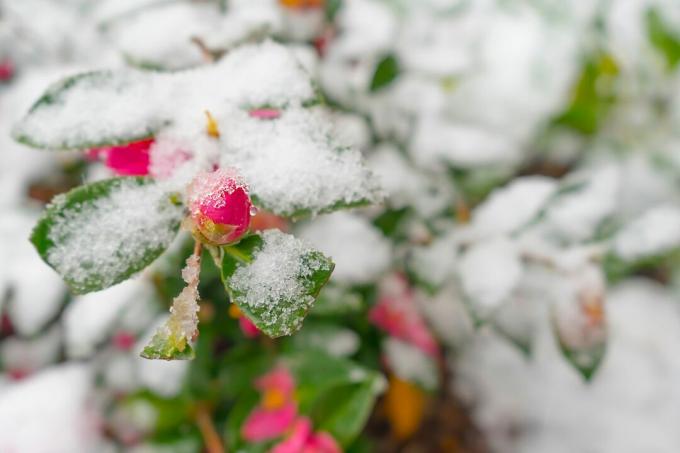
Winter protection for camellias:
- The root area is covered with a breathable garden fleece, a coconut mat or a thick layer of mulch.
- A warm layer of spruce branches, brushwood, leaves or moss offers additional protection.
- Water with lime-free water on frost-free days when the soil above ground has dried so that the root ball is never completely dry.
If particularly frosty temperatures are to be expected, the above-ground part is wrapped in fleece to protect against the cold and drying out. The plants are shaded by the fleece and lose less water through transpiration (protection against cold frost). When the severe frost phase is over, the fleece is removed again so that the plants get enough light. As an alternative to wrapping with fleece, you can also loosely wrap the plants with wire mesh and fill the resulting space with leaves up to half the height of the plant. This way your camellias will still get enough light. In very cold temperatures or when the plants are young, the upper part is also covered with leaves. Wrapped up snugly and thus well protected from sun and cold burns, your camellias will survive Father Frost’s annual visit, even planted out in the garden.
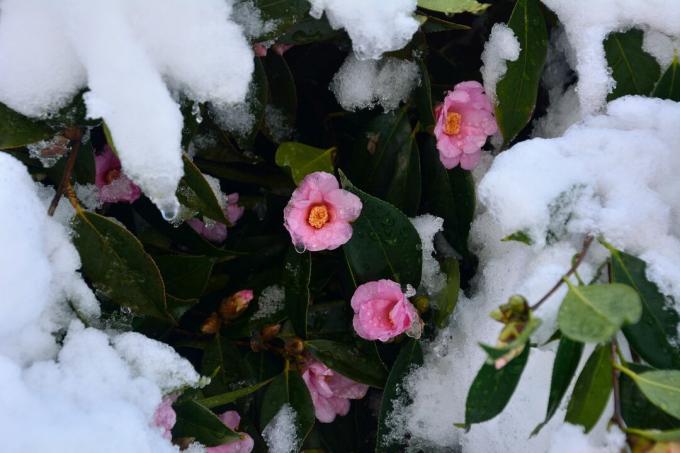
Notice: Remember that the flowering of your camellias in the bed will never match the size and splendor of such specimens that can reach the winter in a bright, optimally tempered conservatory or greenhouse spend.
Overwinter camellias in pots
In the pot, camellias are housed in a frost-free winter quarters, because there is a particular need for plants kept in pots in the cold season there is a great danger that the soil in the pot will freeze through and the pretty plants will not survive the frosty time survive. You should still wait as long as possible before moving to the winter residence. The camellias remain outside until the temperatures drop below freezing for longer periods or at the latest fall below -5 °C. After that, the plants must move to a bright winter quarters.
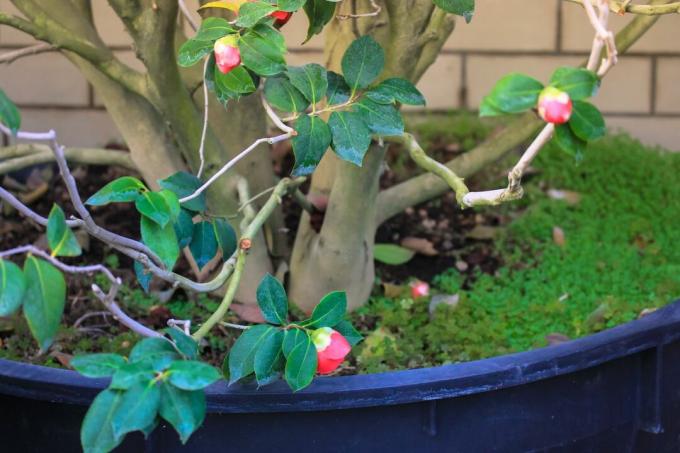
Pay attention to the following conditions when overwintering your camellias and you can enjoy your Asian beauties again next year:
- Temperature: 5 - 15 °C
- Humidity: about 60%
- When the soil has dried above ground, water with lime-free water so that the soil never dries out completely.
- Spray with lime-free, lukewarm water or set up a humidifier to increase humidity.
- There is no need to fertilize until flowering.
It should be avoided at all costs to exceed the limit of 15 °C in winter. Because camellias need a rest period of at least six weeks a year. This is crucial for flower quality and duration. Heated rooms are therefore not suitable as winter quarters. Under the influence of the warm and above all dry heating air, the delicate plants quickly shed their buds and drastically shorten their flowering phase. An unheated conservatory, a greenhouse or a staircase with lots of windows is therefore ideal. Once you have decided on a winter quarters, this should not be changed again, because the tea bushes do not like a spontaneous change of scenery. In January or February, the camellias can finally be moved out again. The temperatures should be at least 5 °C at night. When overwintering potted camellias, not only the spatial environment is decisive, there are also a few things to consider when planting.
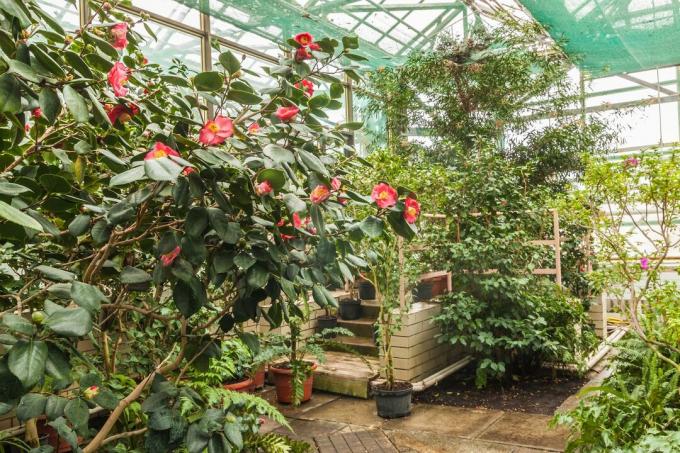
If you let your camellias hibernate in the dark, for example in the basement, the plants must first be slowly acclimated to a brighter and warmer environment after the cold darkness. For this, the hibernators can first wander into the hallway and slowly be watered more again.
Hardy Camellia Varieties: A Selection
When it comes to camellias, you should always keep in mind that some varieties do need as much winter hardiness as possible were selected, but the Far Eastern plants have not yet been made completely hardy will. The extra-robust varieties are usually the result of crossing the species Camellia oleifera and Camellia sasanqua developed.
Here we present 20 particularly cold-tolerant and beautiful camellia varieties for wintering outdoors:
- Alba Plena: double, white flowers from October to January; Growth height up to 2.4 m
- Anticipation: Pink flowers from February to May; Growth height up to 4 m
- Black Lace: double, dark red flowers from March to April; Growth height up to 2.5 m
- Bonomiana: pink flowers with pink-red striped pattern from February to April; Growth height up to 2.5 m
- Debbie: Double, pink flowers from February to April; Growth height up to 2.5 m
- Donation: Semi-double pink flowers
- Elegans: Pink flowers speckled with white from December to May
- Hagoromo: Soft pink flowers from February to April; Growth height up to 3 m
- Hiodoshi: Red flowers from February to May; Growth height up to 3 m

- April Dawn: White-pink flowers with bright pink stripes from February to April; Growth height up to 2 m
- Winter's Snowman: White flowers from October to December; Growth height up to 3.5 m
- Matterhorn: Double, white flowers from February to May
- Mikuni-no-homare: Soft pink-pink veined flowers
- Nuccio's Gem: Double, white flowers from March to April; Growth height up to 2.5 m
- Spring's Promise: Pink blooms in April; Growth height up to 2.5 m
- Tricolor: Blooms February to April in pink, white, and red; Growth height up to 1.5 m
- Spring Festival: Salmon pink blooms from February to April
- Wheeler: Semi-double, dark pink flowers from February to April
- Winter's Joy: Semi-double, bright pink flowers from October to January; Growth height up to 2 m
- Winter's Star: Purple-red flowers from October to November
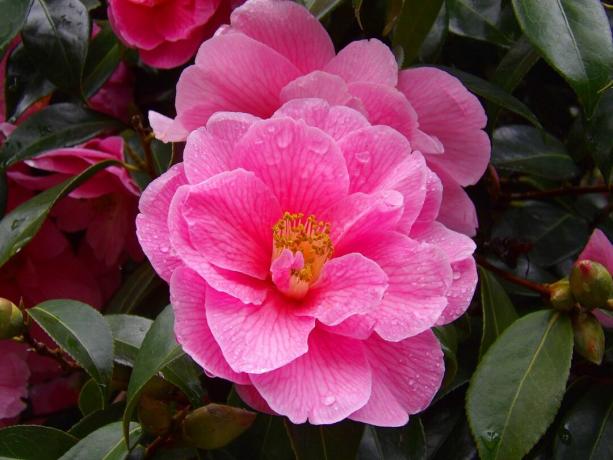
Alternatively, you can also do it the camellia way Camellia sasanqua To fall back on. This species blooms as early as autumn and exudes an intoxicating scent. However, enough Camellia sansanqua not to the colorful and lush bloom of Camellia japonica approach.
More tips on the ideal Caring for your camellia can be found here in our special article.

